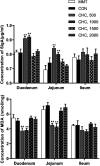Effects of activated charcoal-herb extractum complex on the growth performance, immunological indices, intestinal morphology and microflora in weaning piglets
- PMID: 35517287
- PMCID: PMC9060878
- DOI: 10.1039/c8ra10283j
Effects of activated charcoal-herb extractum complex on the growth performance, immunological indices, intestinal morphology and microflora in weaning piglets
Abstract
This study was conducted to evaluate the effects of activated charcoal-herb extractum complex (CHC) on the growth performance, immunological indices, intestinal morphology and microflora in weaning piglets to determine the optimal supplemental dose. A total of 216 weaned piglets (Duroc × Landrace × Large White) with an initial body weight of 8.55 ± 1.18 kg were randomly assigned to six treatment groups; each treatment group had six pens, with six pigs per pen. The study period was 28 d. Pigs were fed a corn-soybean meal-based diet supplemented with 500, 1000, 1500 or 2000 mg kg-1 of CHC over two 14-d periods. Two additional diets containing 0 and 1000 mg kg-1 of montmorillonite were set as the negative and positive controls, respectively. Supplementation with 500 mg kg-1 of CHC significantly increased average daily gain compared with the positive and negative controls during phase I and the entire experimental period (P < 0.05). During phase I, 500 and 1000 mg kg-1 of CHC significantly decreased diarrhea incidence compared with the negative control, and increased serum IGF-1 and serum IgM levels compared with the controls (P < 0.05). CHC at 500 mg kg-1 significantly decreased the diarrhea score during the entire experimental period compared with the negative control (P < 0.05). On day 28, supplementation with 500 and 1000 mg kg-1 of CHC increased serum IgG, IL-1β, and duodenum and jejunum secretory IgA compared with the negative control and decreased duodenum and jejunum MDA levels compared with the controls (P < 0.05). Increased duodenum and jejunum villus height and an increased ratio of villus height to crypt depth were observed compared with the negative control and decreased viable counts of E. coli in the cecum were detected compared with the controls (P < 0.05). Collectively, the optimal dose of CHC was found to be 500 to 1000 mg kg-1 in this study.
This journal is © The Royal Society of Chemistry.
Conflict of interest statement
The authors declare no competing financial interests.
Figures


Similar articles
-
Beneficial Alteration in Growth Performance, Immune Status, and Intestinal Microbiota by Supplementation of Activated Charcoal-Herb Extractum Complex in Broilers.Front Microbiol. 2022 Apr 15;13:856634. doi: 10.3389/fmicb.2022.856634. eCollection 2022. Front Microbiol. 2022. PMID: 35495714 Free PMC article.
-
Effects of Activated Charcoal-Herb Extractum Complex on Antioxidant Status, Lipid Metabolites and Safety of Excess Supplementation in Weaned Piglets.Animals (Basel). 2019 Dec 15;9(12):1151. doi: 10.3390/ani9121151. Animals (Basel). 2019. PMID: 31847500 Free PMC article.
-
Effects of dietary rosemary extract supplementation on growth performance, nutrient digestibility, antioxidant capacity, intestinal morphology, and microbiota of weaning pigs.J Anim Sci. 2021 Sep 1;99(9):skab237. doi: 10.1093/jas/skab237. J Anim Sci. 2021. PMID: 34370023 Free PMC article.
-
Effect of low dosage of chito-oligosaccharide supplementation on intestinal morphology, immune response, antioxidant capacity, and barrier function in weaned piglets.J Anim Sci. 2015 Mar;93(3):1089-97. doi: 10.2527/jas.2014-7851. J Anim Sci. 2015. PMID: 26020885
-
Effects of dietary Forsythia suspensa extract supplementation to lactating sows and nursery pigs on post-weaning performance, antioxidant capacity, nutrient digestibility, immunoglobulins, and intestinal health.J Anim Sci. 2021 Aug 1;99(8):skab142. doi: 10.1093/jas/skab142. J Anim Sci. 2021. PMID: 34014312 Free PMC article.
Cited by
-
Forsythia suspensa extract enhances performance via the improvement of nutrient digestibility, antioxidant status, anti-inflammatory function, and gut morphology in broilers.Poult Sci. 2020 Sep;99(9):4217-4226. doi: 10.1016/j.psj.2020.05.011. Epub 2020 Jun 17. Poult Sci. 2020. PMID: 32867965 Free PMC article.
-
Beneficial Alteration in Growth Performance, Immune Status, and Intestinal Microbiota by Supplementation of Activated Charcoal-Herb Extractum Complex in Broilers.Front Microbiol. 2022 Apr 15;13:856634. doi: 10.3389/fmicb.2022.856634. eCollection 2022. Front Microbiol. 2022. PMID: 35495714 Free PMC article.
-
Sorption of phenols and flavonoids on activated charcoal improves protein metabolism, antioxidant status, immunity, and intestinal morphology in broilers.Front Vet Sci. 2024 Jan 11;10:1327455. doi: 10.3389/fvets.2023.1327455. eCollection 2023. Front Vet Sci. 2024. PMID: 38274659 Free PMC article.
-
Mitigation effects of plant carbon black on intestinal morphology, inflammation, antioxidant status, and microbiota in piglets challenged with deoxynivalenol.Front Immunol. 2024 Sep 9;15:1454530. doi: 10.3389/fimmu.2024.1454530. eCollection 2024. Front Immunol. 2024. PMID: 39315103 Free PMC article.
-
Effects of Three-Layer Encapsulated Tea Tree Oil on Growth Performance, Antioxidant Capacity, and Intestinal Microbiota of Weaned Pigs.Front Vet Sci. 2021 Dec 2;8:789225. doi: 10.3389/fvets.2021.789225. eCollection 2021. Front Vet Sci. 2021. PMID: 34926648 Free PMC article.
References
-
- Kim J. C. Hansen C. F. Mullan B. P. Pluske J. R. Anim. Feed Sci. Technol. 2012;173:3–16. doi: 10.1016/j.anifeedsci.2011.12.022. - DOI
LinkOut - more resources
Full Text Sources
Miscellaneous

